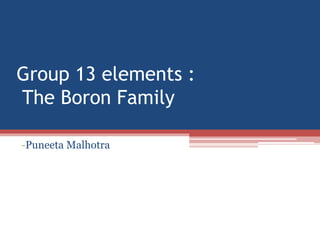
Group 13 elements
- 1. Group 13 elements : The Boron Family -Puneeta Malhotra
- 2. Group 13 • Group 13 or the Boron family has Boron (B) , Aluminium (Al) , Gallium (Ga) , Indium (In) , Thallium (Tl) . • Al is the most abundant metal on Earth . • Al is third most abundant element in the Earth’s crust .
- 3. Electronic Configuration • General electronic configuration ns2np1 • Stable Oxidation state +3 decreases as we move down the group due to inert pair effect.
- 4. What is Inert Pair Effect ? • Reluctance of ns2 electrons to take part in bonding due to the poor shielding effect of intervening d and f orbitals on moving down the group is known as Inert Pair Effect .
- 5. ATOMIC SIZE
- 6. Atomic Radii • Atomic Radii (pm) • B 85 • Al 143 • Ga 135 • In 167 • Tl 170 • On moving down the group atomic radius is expected to increase. • However, Atomic radius of Ga is less than that of Al. due to the poor screening effect of intervening d orbitals
- 7. Ionization Enthalpy • The ionization enthalpy values do not decrease smoothly down the group. • Variation can be explained on the basis of poor screening effect of d and f electrons. • IE1<IE2<IE3 • Sum of IE1+IE2+IE3 is very high
- 8. Electronegativity • B 2.0 • Al 1.5 • Ga 1.6 • In 1.7 • Tl 1.8 • Down the group, electro negativity first decreases from B to Al and then increases marginally because of the differences in atomic size of the elements.
- 9. Physical Properties • Boron is hard black coloured high melting (Due to very strong crystalline lattice) non metallic solid . • Others are soft metals with low melting point and high electrical conductivity. • Density of the elements increases down the group from boron to thallium. • Ga it a useful material for measuring high temperatures as it has low mp and very high bp.
- 10. Oxidation State And Trends In Chemical Reactivity • Except B all other are metals • Boron due to small size and high IE1+IE2+IE3 does not form B3+ , forms covalent compounds. • Aluminum (Al) forms +3 cations. • Gallium (Ga), indium (In), and thallium (Tl) all form +3cations, but also +1 cations . • The relative stability of +1 oxidation state progressively increases as we move down in the group due to inert pair effect Al<Ga<In<Tl
- 11. • BF3 AlCl3 etc behave as LEWIS ACIDS (electron deficient molecules have tendency to accept a pair of electrons to achieve stable electronic configuration) • The tendency to behave as Lewis acid decreases with the increase in the size down the group. • AlCl3 achieves stability by forming a dimer
- 12. Reactivity Towards Air • Boron is unreactive in crystalline form. • Aluminium forms a very thin oxide layer on the surface which protects the metal from further attack. • Amorphous boron and aluminium metal on heating in airform B2O3 and Al2O3 respectively.
- 13. • Basic nature of these oxides increases down the group. • Boron trioxide is acidic ,Aluminium and gallium oxides are amphoteric and those of indium and thallium are basic in their properties.
- 14. Reactivity Towards Nitrogen • Only B and Al forms nitrides at high temperature
- 15. Reactivity Towards Acids and Alkalies • B does not react with acids and alkalies even at moderate temperature. • Al shows amphoteric character. • Aluminium dissolves in dilute acids and alkalies and liberates hydrogen. • In concentrated HNO3 Al becomes passive by forming a protective oxide layer on the surface.
- 16. • Aluminium dissolves in dilute acids and alkalies and liberates hydrogen. • In concentrated HNO3 Al becomes passive by forming a protective oxide layer on the surface.
- 17. Reactivity Towards Hydrogen • These elements react with halogens to form tri halides(except TlI3). • 2E(s)+ 3 X2(g)→ 2EX3(s) (X = F, Cl, Br, I)
- 18. Reactivity towards halogens • These elements react with halogens to form trihalides (except Tl I3). • 2E(s) + 3 X2 (g) → 2EX3 (s) (X = F, Cl, Br, I)
- 19. ANOMALOUS PROPERTIES OF BORON • Due to small size and high electronegativity, form covalent compounds • due to the absence of d orbitals that the maximum covalence of B is 4.
- 21. Borax Na2B4O7⋅10H2O • tetranuclear units [B4O5 (OH)4]2-. Correct formula; therefore, is Na2[B4O5 (OH)4].8H2O. • Borax dissolves in water to give an alkaline • solution. • Na2B4O7 + 7H2O → 2NaOH + 4H3BO3 (Orthoboric acid)
- 22. borax bead test • Na2B4O7.10H2O ( heat)→Na2B4O7 Sodium metaborate • Na2B4O7 (heat) →2NaBO2 + B2O3 Boric anhydride • The metaborates of many transition metals have characteristic colours and, therefore, borax bead test can be used to identify them in the laboratory.
- 23. Orthoboric acid H3BO3 • Boric acid is a weak monobasic acid. • It is not a protonic acid but acts as a Lewis acid by accepting electrons from a hydroxyl ion: • B(OH)3 + 2HOH → [ • On heating, orthoboric acid above 370K forms metaboric acid, HBO2 which on further heating yields boric oxide, B2O3.
- 25. Diborane, B2H6
- 26. • Each B atom uses sp3 hybrids for bonding. Out of the four sp3 hybrids on each B atom, one is without an electron shown in broken lines. The terminal B-H bonds are normal 2-centre-2- electron bonds but the two bridge bonds are 3- centre-2-electron bonds. The 3-centre-2- electron bridge bonds are also referred to as banana bonds.
- 27. Thank You
Notas do Editor
- thallium +1 oxidation state is predominant whereas the +3 oxidation state is highly oxidising in character.